- About Us
- Columns
- Letters
- Cartoons
- The Udder Limits
- Archives
- Ezy Reading Archive
- 2024 Cud Archives
- 2023 Cud Archives
- 2022 Cud Archives
- 2021 Cud Archives
- 2020 Cud Archives
- 2015-2019
- 2010-2014
- 2004-2009
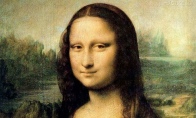 |
December 2010 - Welcome To Weirdsville |
If it had been done in this age of iPhones, iPads, and amid everything else in this high tech era, the movie would have had a George Clooney or Bruce Willis dangling upside down over a pick-up-sticks weave of alarm lasers while a geeky cohort (maybe Steve Buscemi or Alan Cumming), face green from the digital overload bouncing up from a laptop, rattled off a second-by-second update on the imminent wee-oo-wee-oo arrival of the stern-jawed Groupe d'Intervention de la Gendarmerie Nationale.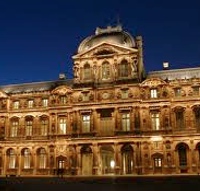
But while the lady did vanish – a very, very special lady – the means of her vanishing, while maybe a tad less dramatic, was no less fascinating.Though you'll no doubt immediately recognize the lady in question, you may not know her full name, or some of the more interesting details of her portrait. Begun by a certain well-known artist back in 1503, the likeness of Lisa del Giocondo wasn't finished until some years later, around 1519. After the death of this rather well known artist, the painting was purchased by King François I, and then, after a certain amount of time in the ownership of other kings, it finally ended up in the Louvre. An interesting note, by the way, is that – while not a King – the painting was borrowed from the Louvre by Napoleon to hang in his private quarters, and was returned to that famous French museum when the Emperor became ... well, not the Emperor.
Its official title is 'Portrait of Lisa Gherardini, wife of Francesco del Giocondo' but the smile says it all, and in 1911 it was stolen – and wasn't returned until 1913. 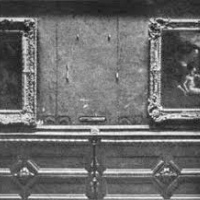
While much of the theft is still a mystery, what is known is that on August 22, 1912, Louis Béroud, a painter and fan of the legendary Mona Lisa, came into the Louvre early one morning to study the famous work of Leonardo da Vinci, instead finding a bare wall. In a pure Inspector Clouseau bit of history, the museum staff didn't immediately put bare wall and missing painting together and instead thought the painting had been taken away to be photographed. It took Béroud, checking with the photographers themselves, to bring it to the attention of the guards that the painting had been stolen.
Suspects were many and varied: a curious one was Guillaume Apollinaire, the critic and surrealist, who, because he once called for the Louvre to be burnt to the ground, was actually arrested. While no-doubt annoying, he was eventually cleared and released, but not before trying to finger, unsuccessfully, a friend of his for the theft, another rather well known painter by the name of Pablo Picasso.
Alas, the actual thief and the method of the robbery are almost painfully plain, though the man and the means weren't discovered until much later. In 1913, Vincenzo Peruggia, a Louvre employee, was nabbed when he contacted Alfredo Geri, who ran a gallery in Florence, Italy, about the stolen painting.
The story that emerged after his arrest was that on August 20th, 1912, Peruggia had hidden in the museum overnight.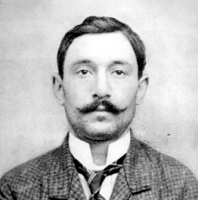 On the morning of Sunday, the 21st, he emerged from hiding, put on one of the smocks used by employees and, with ridiculous ease, simply took what is arguably the most famous painting in the world and put it under his coat and walked out the door. When the gendarmes later knocked on Peruggia's door they'd simply accepted his excuse that he'd been working somewhere else the day of the theft while the painting was hidden under his bed.
On the morning of Sunday, the 21st, he emerged from hiding, put on one of the smocks used by employees and, with ridiculous ease, simply took what is arguably the most famous painting in the world and put it under his coat and walked out the door. When the gendarmes later knocked on Peruggia's door they'd simply accepted his excuse that he'd been working somewhere else the day of the theft while the painting was hidden under his bed.
What isn't plain, though, was Peruggia's motivation for the theft. While he constantly argued he'd stolen the Mona Lisa for patriotic reasons, to hopefully return it to his native Italy, many believe a more intriguing, more nefarious, more devilishly elegant explanation – an explanation that involves one of the most legendary crooks and conmen who have ever lived: Eduardo de Valfierno.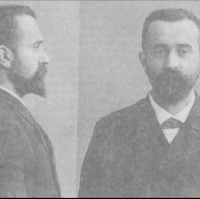
Born in Argentina, Valfierno, who liked to call himself a Marqués, was a man with not just a plan, but also a remarkably clever plan. According to those who believe he had a hand in the affair, the Marqués began by commissioning not one, not two, not three but instead six copies of the painting from the equally-legendary forger Yves Chaudron. Now there's no way anyone would buy a Mona Lisa when the real one was clearly hanging on a wall in the Louvre, so Valfierno hired the poor Peruggia to make off with the original.
Once the original painting was reported missing, Valfierno took his six perfect forgeries and sold them to illicit collectors all over Europe, convincing each and every one that the Mona Lisa they were purchasing was the one and only original. Waiting for the elegant part of this plan? Well, even if Valfierno had been caught, the only thing be could have been nailed for was selling forgeries, which none of the collectors he'd sold to were ever willing to report to the authorities as it would have incriminated themselves as well. In an an extra bonus, Valfierno could have sold as many copies as he wanted so long as the original painting stayed missing. 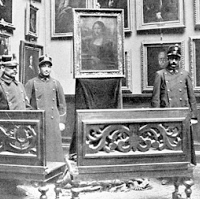
For those who like to tie Valfierno to the crime, Peruggia only tripped up the whole scheme when he realized that Valfierno had stuck him with the serious end of the crime – the theft – and he'd stumbled when trying to sell the Mona Lisa or, as he claimed, simply trying to return it to his native Italy.
The tale, though, does has a somewhat happy ending: Peruggia, despite the outrage over the theft of the painting in France, was given a rather lenient sentence by the Italian authorities, who felt moved by Peruggia's claim to have been motivated by patriotism. While little is known about the possible mastermind, Valfierno, considering the brains and creativity involved it's not a huge stretch to imagine him doing quite well afterward.
Meanwhile, The Portrait of Lisa Gherardini, wife of Francesco del Giocondo, was returned to her noble spot in the Louvre where she smiles out as us to this day: her cryptic expression as mysterious as the shadowy history surrounding her theft in 1911.
M.Christian has published more than 300 published short stories, is the editor of over 20 anthologies - including The Burning Pen, Guilty Pleasures, The Mammoth Book of Future Cops and The Mammoth Book of Tales of the Road (with Maxim Jakubowksi) and Confessions, Garden of Perverse, and Amazons (with Sage Vivant) - and is the author of the collections Dirty Words, Speaking Parts, The Bachelor Machine, Licks & Promises, Filthy, Love Without Gun Control, Rude Mechanicals, and Coming Together: M.Christian; and the novels Running Dry, The Very Bloody Marys, Me2, Brushes, and Painted Doll.
